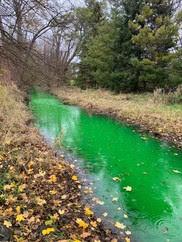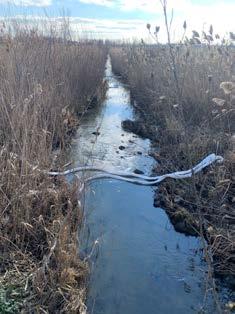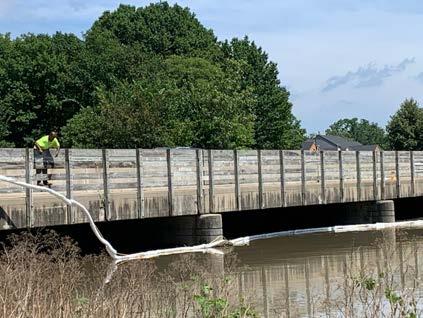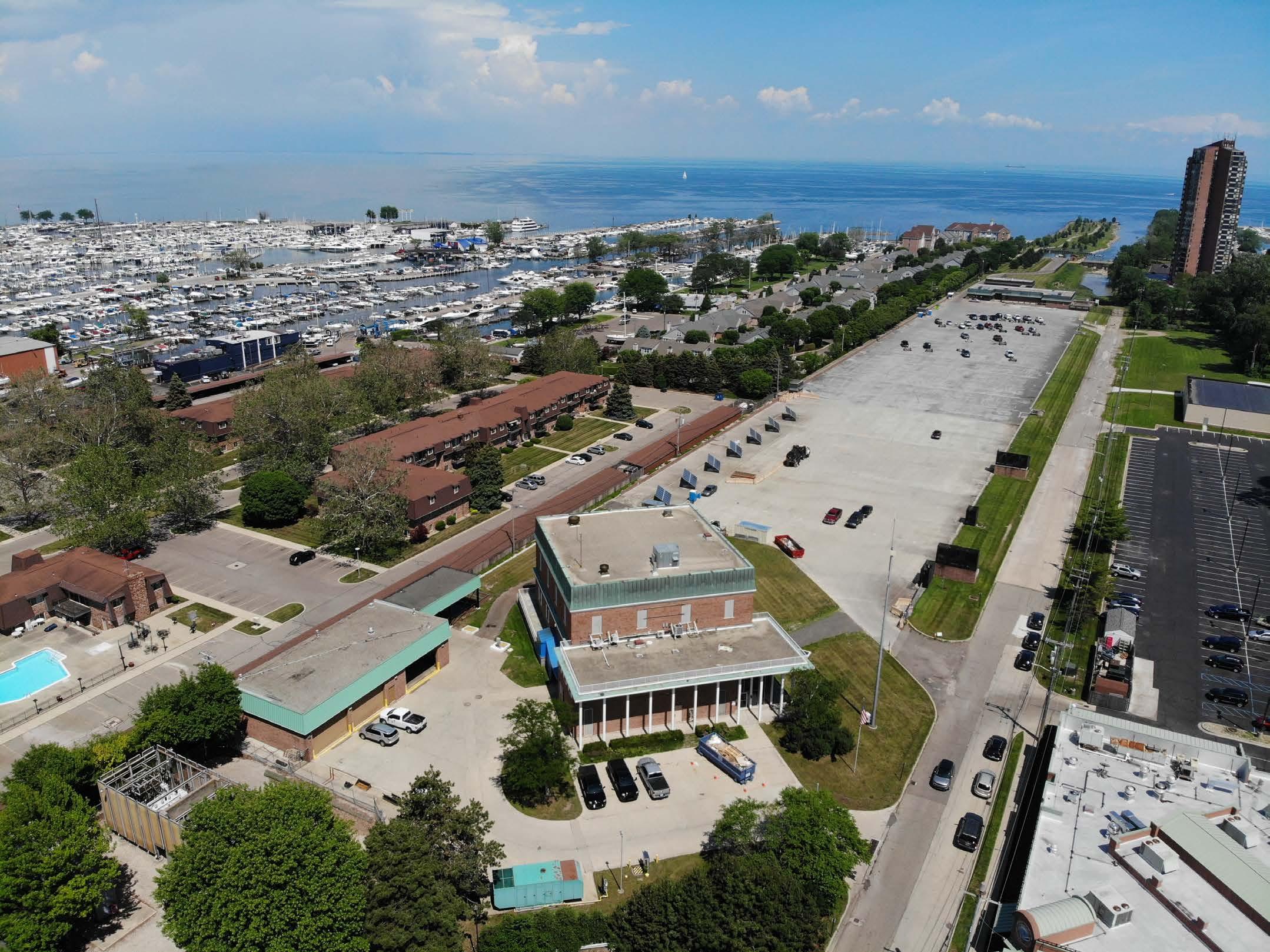










TheMacombCountyPublicWorksOfficehasthreegoals: improvewaterquality,toimprovethequalityoflifeforourresidents,andtoserveasa criticalcomponentofeconomicdevelopmentinourcommunity.
TheMCPWOadministers474countydrainsthatpreventfloodinginourcommunities. Someofthesedrainsareopenstreamsorcreeks,whileothersaremassiveunderground structuresthatcarrystormwaterawayfromneighborhoodsandbusinesses.Givenour responsibilityforthesewaterways,weareactivelyengagedinnumerousinitiativesto enhancetheoverallwaterqualityinourlakesandrivers,mostnotablytheClintonRiver andLakeSt.Clair.Inaddition,weoperate68milesofsanitarysewerlineswhichtransport wastefrommorethan800,000residentsandbusinessestotheGreatLakesWater Authority(GLWA)WaterResourceRecoveryFacility(WRRF)forpropertreatment.


Candice S. Miller
Dear Neighbors,
At the Macomb County Public Works Office, our team has been busy tackling drainage projects and regular tasks in order to protect our waterways, the environment and being an important component of economic prosperity. Everything we do is with an eye on water quality. I remain committed to reducing – and hopefully eliminating -- combined sewer overflows in order to protect our beautiful Lake St. Clair. It’s a primary reason I ran for this office. As part of that effort, we’re making progress with projects that will further reduce CSO’s. Details of those projects are included in this report.

One of the biggest challenges last year was the rainstorm of June 25-26. Almost 4 inches of rain fell in southeast Macomb County. Other areas in metro Detroit reported between 5-7 inches of rain, leading to widespread flooding in the Grosse Pointes, in northeast Detroit and Dearborn. No storm water system can fully handle that amount of rain. Combined storm water and sanitary flow rapidly filled our Chapaton Retention Basin, and our team released the chemically treated flow from the Nine Mile Emergency Bypass. The decision to release the emergency bypass prevented basement flooding in up to 4,000 homes!
Further north in Macomb County, the water level was high in many open-channel drains following the torrential downpours. Thanks to extensive drain maintenance during the last four years by our crews to remove logjams and other debris, the drains performed well. Some of these drains, including creeks and streams, hadn’t undergone any drain maintenance in decades.
Meantime, construction involving the rehabilitation of the Macomb Interceptor Drain continues. At 40 to 70 feet below the surface along 15 Mile Road, this kind of construction isn’t very noticeable from the road. But it’s extremely important, because we must ensure we never have another major sewer collapse and sinkhole.
Last summer’s heavy rain events were a stark reminder that we must have major investment in our underground infrastructure. Deteriorating pipes that are several decades old must be replaced or lined. Aging equipment including huge pumps must be replaced or maintained.
Our staff conducted almost 10,000 inspections last year – checking for soil erosion, inspecting construction of storm drains, drain taps and crossings, and sanitary sewers. Our Soil Erosion/Soil Control team issued more than 1,100 soil erosion permits. Our Plan Review division is a major component of economic development, and reviewed 180 engineering plans for residential, commercial and industrial projects or redevelopments.
Our online permit portal that allows anyone to apply for a permit, submit plans and pay fees in one convenient location online, at any hour of any day, has been very popular.
We’re committed to transparency in everything we do, and I encourage you to read this report. You can also visit us at macombgov.org and click on the Macomb County Public Works page to learn more about our activities and services. Check us out on social media. You also can contact us by email at public.works@macombgov.org or by phone at (586) 469-6101.
Sincerely,

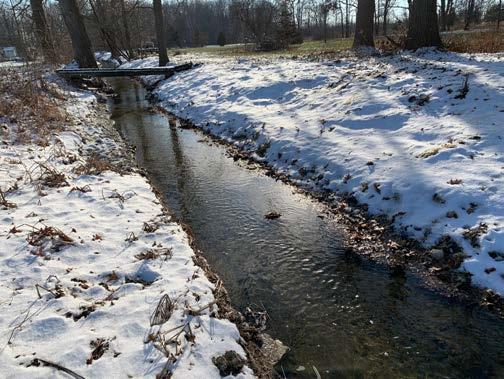
Logjams and debris can impede water flow – which can cause erosion and destabilization of the banks which can lead to more trees falling into the water. It also hurts water quality. Through our drain maintenance efforts, removing those logjams and trash reduces the chances of flooding. Sediment is removed and placed on the banks, graded and topped with a bed of top soil, grass seed and a mulch blanket.
Removal of the logjams and debris at the Clinton River, the Yates Drain in Washington Township, the Conklin Drain in Macomb Township and many others under the jurisdiction of the Macomb County Public Works Office (MCPWO) was made possible through our 50/50 match program started by MCPWO and Public Works Commissioner Candice S. Miller, in cooperation with the Macomb County Board of Commissioners, to target smaller drain improvement projects.
During the last four years, MCPWO has worked with local officials on drain maintenance in every community in the county.
Together, with other maintenance efforts inside open drains that hadn’t been addressed for many years, Macomb County is seeing the benefits of our program. After multiple rain events from 2 to 7 inches in parts of metropolitan Detroit in the summer of 2021, the storm water drained
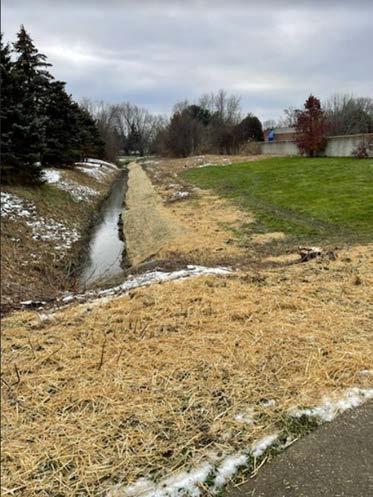
pretty quickly in Macomb County following those torrential downpours. While in neighboring Wayne County it led to flooding of thousands of basements plus freeways and heightened regional awareness of the need to improve underground infrastructure and promote new green infrastructure.
In addition to the cost sharing program, Macomb County Public Works has also used grant funds and prior assessments to inspect, maintain and improve county drains. In 2021, work was performed in more than 100 drains under the county’s jurisdiction.
“We’re especially proud of the success and results of this partnership with the local governments, and we look forward to continuing it indefinitely,” said Miller, “We couldn’t do this without the support of the county Board of Commissioners.”
“Instead of spending a sizable amount on just a few drain maintenance projects, we are able to stretch these county dollars wider and clean up more drains with the participation of the local governments,” Miller said.
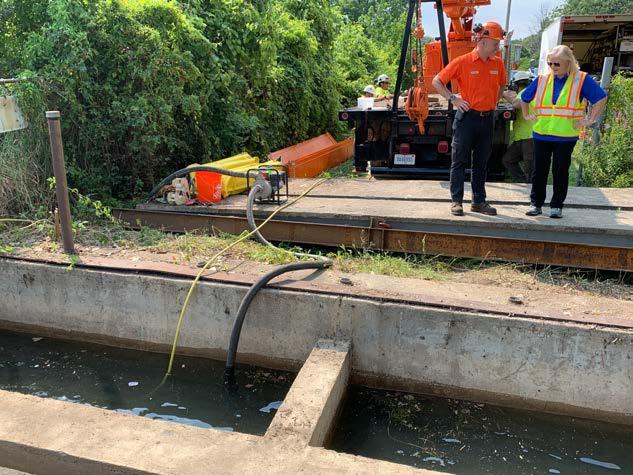
The Macomb County Public Works Office launched a new project to reduce the amount of trash that reaches Lake St. Clair.
The pilot project began last summer within a storm drain that drains thousands of acres of Roseville and St. Clair Shores and discharges into Lake St. Clair at Jefferson Avenue and Martin Road (11 ½ Mile).
“We don’t have to keep living this way,” Macomb County Public Works Commissioner Candice S. Miller said, “and with our beautiful Lake St. Clair, we’re always looking for ways to improve water quality. Our goal is to remove trash before it gets into the lake.”

Macomb County Public Works engineers designed the plan, which features installation of a steel bulkhead plus a boom at the outlet of the sewer to capture floating debris before it flows out into the lake. We are improving the design with a fixed grate, if the project proves to be effective, an identical strategy to reduce pollution in the lake could be deployed at 11 other drains in Macomb County that empty into Lake St. Clair, including those in Harrison Township, Mount Clemens and New Baltimore and St. Clair Shores.
You can track how much precipitation has fallen in your area by checking the Macomb County Public Works Office’s online data from our department’s rain gauges.
In recent months, we completed the installation of 24 rain gauges across the county. The near-real-time data can be viewed on an interactive map on the Public Works website main page.
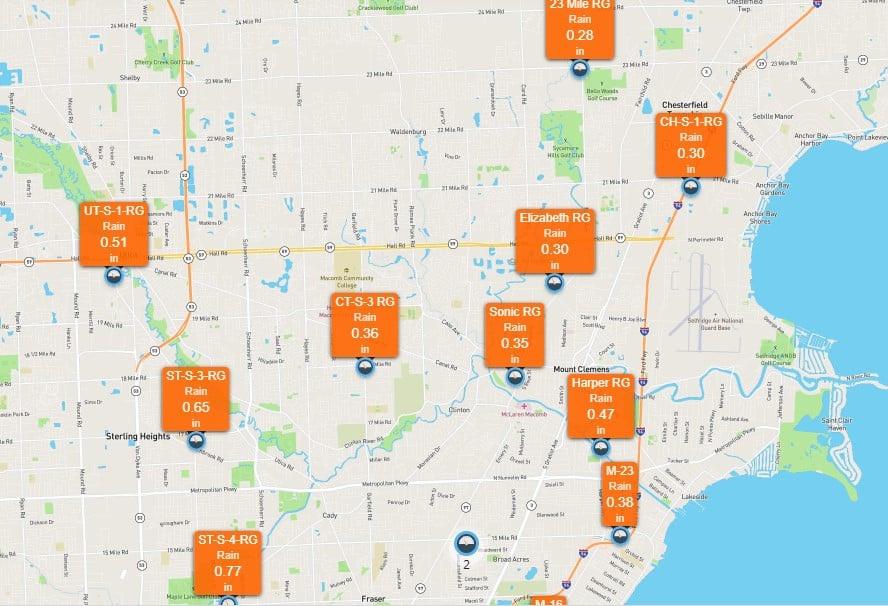
Our crews are busy restoring the strength and integrity of our underground interceptors, at critical locations like the intersection of M-59 and Garfield Road. Here, we are injecting grout into voids in the pipe, before we reline the pipe with impervious material which will last generations.
It’s extremely important that underground infrastructure be inspected and maintained like this, and the Macomb County Public Works Office is committed to doing that.
“With all the money already spent to repave Hall Road, can you imagine how costly and disruptive it would be to have an interceptor collapse at or near that critical intersection, like the sinkhole that occurred just over five years ago on 15 Mile Road in Fraser?” Public Works Commissioner Candice S. Miller said. “That’s why our office takes a proactive approach.”
Workers are often on the job in the massive concrete pipes late at night when the flow is typically lighter. In the roadway, portable lights are set up for safety but we urge motorists to be extra cautious when approaching a work site or spotting traffic barricades in any lane.
The grouting crew has now relocated and will begin work at a different major intersection -- Garfield at Metropolitan Parkway in Clinton Township .
The largest sewer inspection program ever performed by the Macomb County Public Works Office continues.
The sweeping inspections began in 2021 after the contract to inspect 26 miles of the largest sanitary sewers was awarded in December 2020 to Warren-based Doetsch Environmental Services. The company is inspecting 26 miles of the largest sanitary sewers that are under the jurisdiction of the Macomb County Public Works Office, ranging in size from 11-foot-diameter interceptors, to some that are only 12 inches across. More than 360 manholes, eight junction chambers and eight drop shafts/connecting sewers will be checked.
Non-reinforced concrete pipes will now be inspected every three years, and reinforced concrete pipes will be checked every six years. Inspections are important to detect and repair infiltration that, left unchecked, could cause pipes to collapse.
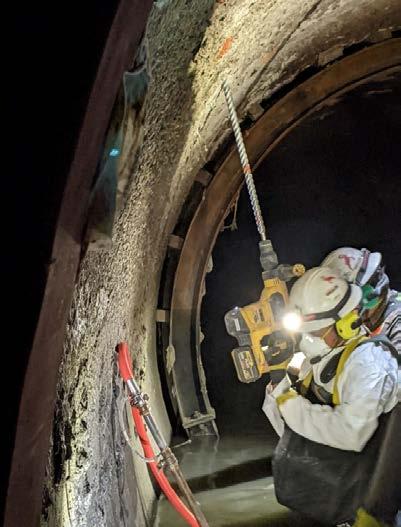
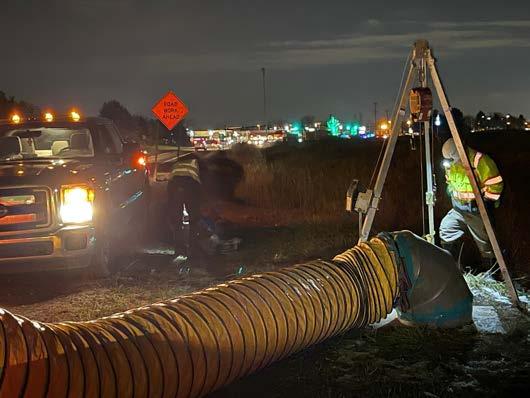
Here’s another welcome indication that the water quality of the Clinton River is improving. A log recently pulled from the river in Harrison Township was partially covered with two gelatinous colonies of freshwater bryozoan. Individually, the tiny marine animals are called zooids and are approximately 0.5 mm in size, and form globs after attaching to rocks, logs or sticks in the water. They use their tentacles to filter the water by trapping algae and unwanted microscopic organisms.

The Sterling Relief Drain drains the stormwater from 20% of Sterling Heights. Two miles of the drain were redesigned and retrofitted to force stormwater flow into a naturalized green corridor after “daylighting” – or exposing – portions of pipe to make it act more like an intermittent stream. The ground then acts as a sponge, soaking up harmful nutrients and sediment from the flow before it has a chance to reach the Red Run Drain, the Clinton River and Lake St. Clair.
Approximately 135,000 native perennial plant plugs were planted on the slope and bottom of the open channel including native pollinator plants to create a 2.5-mile-long butterfly flyway. More than 1,000 shrubs were planted in the bio-retention areas and hundreds of native species trees were planted to establish a tree canopy.


TheMacombCountyPublicWorksOffice’s “daylightingandgreeninfrastructureretrofit” oftheSterlingReliefDraininSterlingHeights wasawardedProjectoftheYearinthe categoryofQualityofLife/$1Millionto $5Million,bytheMichiganchapterofthe AmericanPublicWorksAssociation.
“We’re proud and honored to receive this award from the APWA,” Public Works Commissioner Candice S. Miller said. “Like we always say, ‘Water quality equals quality of life,’ and this project has been a notable and innovative effort to improve both.”
Heavy rain events in the summer of 2021 put a strain on storm water infrastructure and open drains in southeast Michigan, but Macomb County Public Works staff rose to the challenge.
In early June, equipment and operational changes at the Chapaton Pump Station in St. Clair Shores enabled our station operators to avert the discharge of as much as 9 million gallons of combined sewer flow into Lake St. Clair following 1.5 inches of rain over a 6-hour period.
Nearly 4 inches of rain fell on June 25-26 in southeast Macomb County. The crew at Chapaton opened the emergency bypass which sent chemically treated combined storm water and sanitary sewage into Lake St. Clair. It was the first time in many years that the emergency bypass was used.
“Our team really prevented thousands of basements in St. Clair Shores and Eastpointe from flooding and spared the many residents from the messy cleanup and having to throw away furniture or other personal possessions,” Commissioner Candice S. Miller said.
Further north in Macomb County, the water level was high in many open channels, going across some roads and creeping close to yards of homes built close to drain easements. Thanks to extensive drain maintenance during the last four years by our drain maintenance crew to remove logjams and other debris, and the removal of sedimentation, the drains performed well.

To reduce the risk of flooding during heavy rain events on Interstate 94, our drain maintenance crew frequently pull debris from grates at drain crossings to ensure flow is not impeded.
Water levels receded significantly in less than 24 hours.
“Some of these drains, including creeks, streams and branches of the Clinton River, hadn’t undergone any drain maintenance for decades. The work of our crews in recent years also prevented crops from being completely underwater in farmers’ fields in the northern part of the county, which would have meant economic devastation for many farmers,” Miller said.
In September, Public Works drain maintenance staff was proactive and cleared debris from major grates, including along Interstate 94 to reduce the risk of freeway flooding, in advance of heavy rain and a flood watch.
MCPWO also urged residents and businesses to clear trash and other debris from the catch basins on their streets, and not push debris through the grates but instead, pick it up and toss it into a garbage can or trash bin.
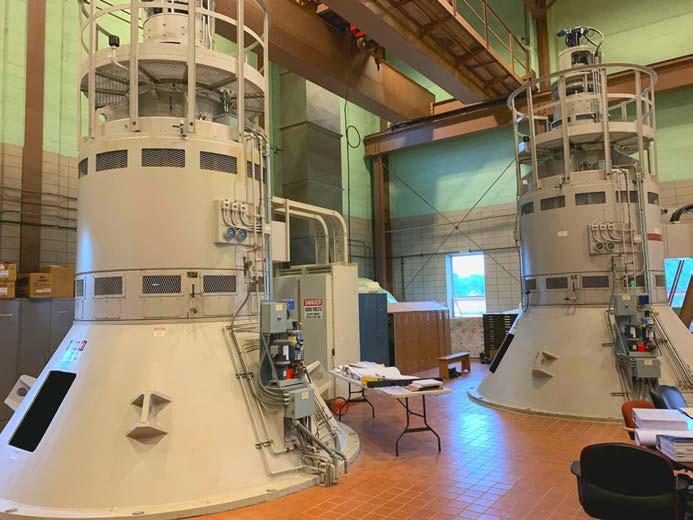
A big “Thank You” to our team at the Chapaton Pump Station and Retention Treatment Basin in St. Clair Shores. Led by Operations and Flow Manager Vince Astorino, the crew worked long hours in emergency mode during and after two enormous downpours this past summer, with the pumps working over capacity and overheating with alarms going off.
“This dedicated group has literally saved thousands of basements in St. Clair Shores and Eastpointe from flooding,” Macomb County Public Works Commissioner Candice S. Miller said. “They are the unsung heroes.”
Thanks to operational changes by the Macomb County Public Works team, we were able to prevent 60 million gallons of combined storm water and sanitary sewage flow from being discharged into Lake St. Clair in 2021.
“Reducing CSO’s is one of the main reasons I ran for this office,” Public Works Commissioner Candice S. Miller said. “While the state allows treated discharges to a certain level, that doesn’t make it right. Pushing the problem on to the next generation shouldn’t be acceptable.”

For example, on June 20-21, 2021, more than 1.5 inches of rain fell in the drainage district that handles storm water and sanitary sewage from most of St. Clair Shores and all of Eastpointe. No two rain events are alike, but that much precipitation over a period of approximately six hours normally would have required the discharge of almost 9 million gallons of chemically treated CSOs. However, the overflow was averted because new manhole covers and seals installed atop the 70-foot-deep wet well inside the Chapaton Pump Station creates a higher operational elevation in the well. Correspondingly, that allows millions of gallons of combined flow to be “stored” upstream in the massive sewer until the rain event
passes and the flow can be sent further down the pipe to the Great Lakes Water Authority waste water treatment plant instead of discharging it into the lake.
Later that month, a storm that dumped between 5 inches and 8 inches of rain in the Jefferson Corridor in northeast Detroit and the Grosse Pointes resulted in widespread flooding. Southeast Macomb County had almost 4 inches of rain, but no storm water system is designed to handle that much rain. It resulted in the discharge of treated flow into the lake, but that decision prevented basement flooding in as many as 4,000 homes in St. Clair Shores.
We are proceeding with a project that calls for installation of a series of inflatable rubber bladders in the Chapaton interceptor to temporarily hold back flow. The project is expected to reduce the volume of CSO’s by 30% at Chapaton and 20% a year at the Martin Retention Basin. Similarly, a second project that will create additional storage of 3.6 million gallons of combined flow includes installation of a weir inside the Martin Drainage District interceptor that serves 78% of Roseville and 22% of St. Clair Shores.
"Pushing the problem on to the next generation shouldn’t be acceptable.”
-Candice S. Miller
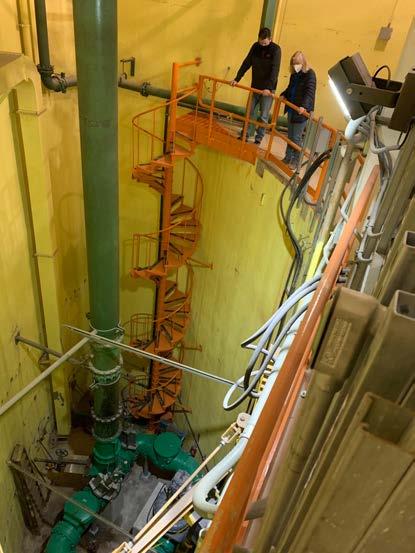

Work continues on two major construction projects to prevent sewer collapses and sinkholes like the one that occurred in December 2016.
Both projects involving the Macomb Interceptor Drain are ongoing far below the surface. Along 15 Mile Road, west of Schoenherr Road in Sterling Heights, the construction contractor spent several months digging a massive shaft to a depth of 60 feet to reach and cut open the massive, 11-foot-diameter concrete pipe that carries the sewage from almost 600,000 people in 11 Macomb County communities. Known as the “Segment 5” project, the crew installed a flume to carry the wastewater flow to enable the rest of the pipe at the bottom of the shaft to be demolished. Moving upstream from there, sediment which may have been building up for years was removed. Crews will install impervious lining to protect 7,000 linear feet of the non-reinforced concrete pipe from corrosion caused by hydrogen sulfide sewer gas. In a stretch of 8-foot-diameter pipe, 1,300 linear feet will be coated with a corrosion resistant geo-polymer spray. A permanent pump station will be built where the shaft is located.
Approximately three miles east of the Segment 5 shaft, a second contractor is working 40 feet below the surface along 15 Mile Road, just east of Garfield Road along the Clinton Township-Fraser border, on Segment 6. This rehabilitation project will include the slip lining of approximately 2,100 feet of 5-footdiameter concrete pipe along 15 Mile Road with impervious lining.
Around the end of spring or early summer 2022, a second phase of Segment 6 sewer maintenance is scheduled to begin to the immediate west. It will include the slip lining of a 1,200-foot curved portion of the 11-footdiameter Romeo Arm Interceptor, at the 15 Mile-Garfield intersection. There will also be installation of an “air-jumper” just west of the intersection which will be connected to the existing bio filter. This will help alleviate odor issues prevalent in this area for years.
“These projects are very significant and their importance can’t be understated,” Macomb County Public Works Commissioner Candice S. Miller said. “We realize the temporary lane closures may be an inconvenience to some motorists, and we appreciate everyone’s patience. However, the alternative – another sewer collapse if we don’t perform drain rehab work – would be much worse.”

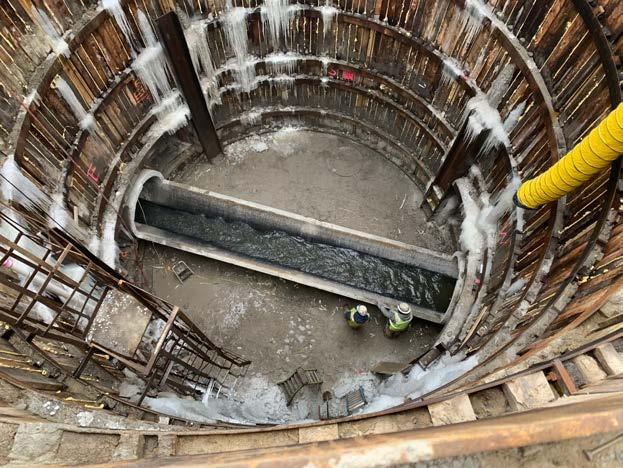
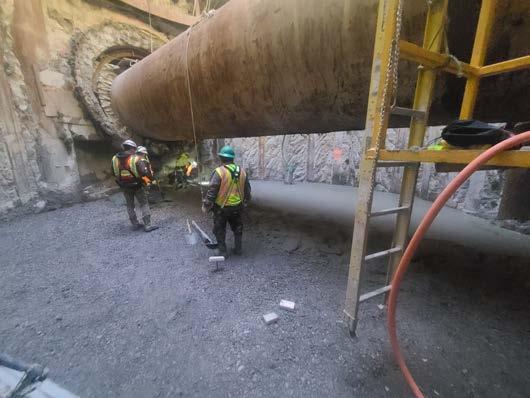

40 feet below the surface, a construction crew "exposes" the interceptor by cutting and removing a section of the concrete pipe in Segment 6 of the MIDD, on 15 Mile, east of Garfield Road.
AtSegment5oftheMacomb InterceptorDrainsewerrehabilitation, on15MileRoadintheITCcorridor,the constructioncontractorworksatthe bottomoftheshaftandnexttothe flumecarryingthesanitarysewage fromthe11communitiesinthe MacombInterceptorDrainDrainage District.
CrewsatSegment5areworking approximately70feetbelowgrade andconstructingwhatwillbecome thepermanentpumpstation.

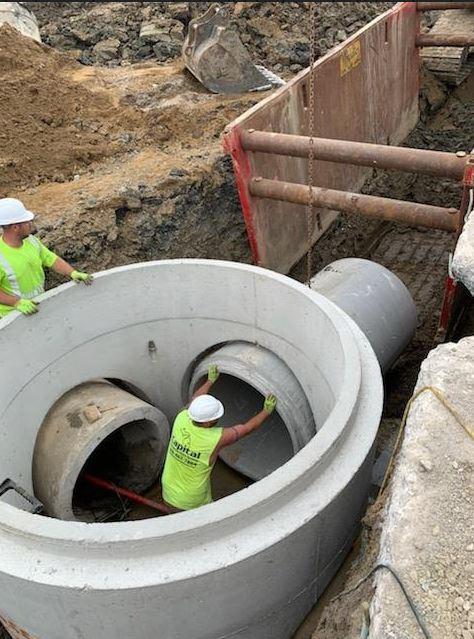
ManyMacombCountyPublicWorksprojects andactivitieshelpushernewbusinessand residentialdevelopment,whichiswhywe’rean importantcomponentofeconomicprosperity forMacombCounty.Sometimeswe’reclosely involvedinpublicsectorprojectsaswell.
AttheJunctionDraininSt.ClairShores,we recentlyrelocatedandinstalled350feetofnew reinforcedconcretepipetoallowforthe expansionofJeffersonMiddleSchool.Thenat GreenwoodElementarySchool,320feetof rottedmetalpipewasreplacedwith48-inchdiameterconcretepipe.

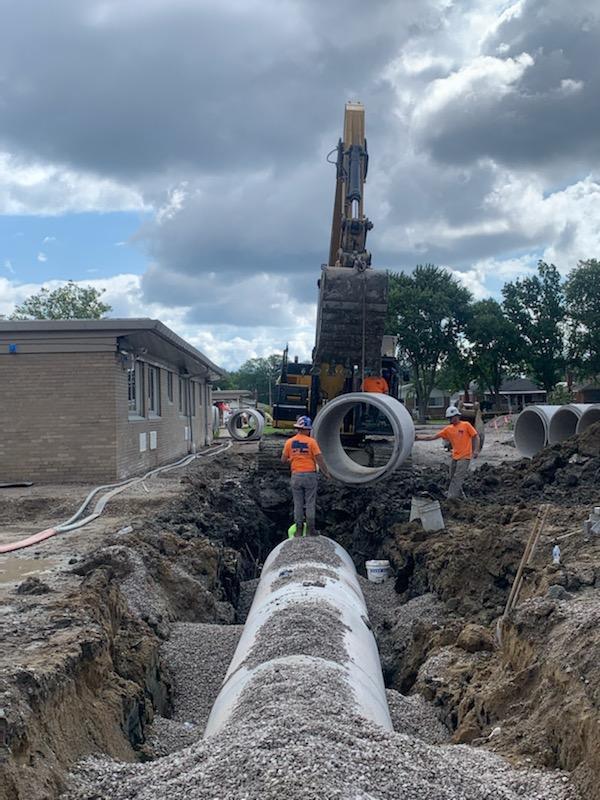
“Thisisagreatexampleofapublicpartnership thatwillbenefitthestaffandstudentsatboth schoolsandtheentireLakeviewPublicSchools communityforgenerations,”PublicWorks CommissionerCandiceS.Millersaid.“We’re gladtohavebeenapartofit.”
Aportionofthetwoprojectcostswaspaidby St.ClairShoresusingsomeofthecity’s economicstimulusfunds.WeappreciateMayor KipWalbyandtheentireCityCouncilfortheir assistance.
Request a drain permit or soil erosion permit
Submit plans for review by Public Works staff and schedule an inspection
See comments by engineers and inspectors in real time Pay the permit fee online using a credit card

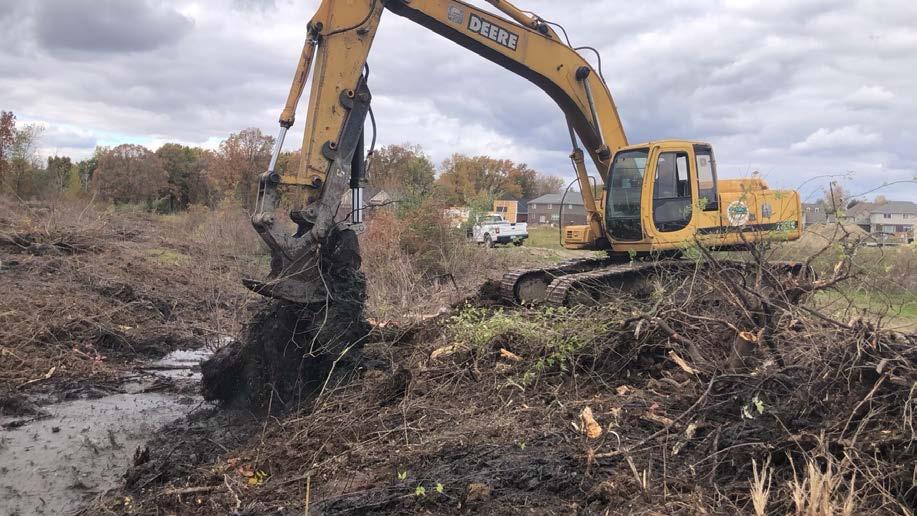
“While the surface improvements are what motorists will enjoy when this major 2-year project is complete, underground infrastructure is just as important."
- CANDICE S. MILLER

The Macomb County Public Works Office is a key component of economic development and prosperity. Our staff helps usher new residential, commercial and industrial projects by reviewing engineering plans to ensure proper storm water drainage -- whether through enclosed sewer pipes or watercourses such as creeks, streams and the Clinton River – and then inspecting that work. For example, we’re monitoring the work at the Pitts Drain near 23 Mile and Chesterfield roads for the next phase of the Hidden Creek Estates subdivision in Chesterfield Township.
During the first phase of the reconstruction of Gratiot Avenue in Roseville, we inspected the work performed by the contractor as the crew crossed the Lake Boulevard Drain and the 11 ½ Mile Drain by drilling taps and installing new concrete pipe to ensure proper drainage along the road and for nearby businesses and homes.
“This is a great road project,” Macomb County Public Works Commissioner Candice S. Miller said. “While the surface improvements are what motorists will enjoy when this major 2-year project is complete, underground infrastructure is just as important. In this case, ensuring good drainage to maintain the integrity of the road for decades,” Public Works Commissioner Candice S. Miller said.

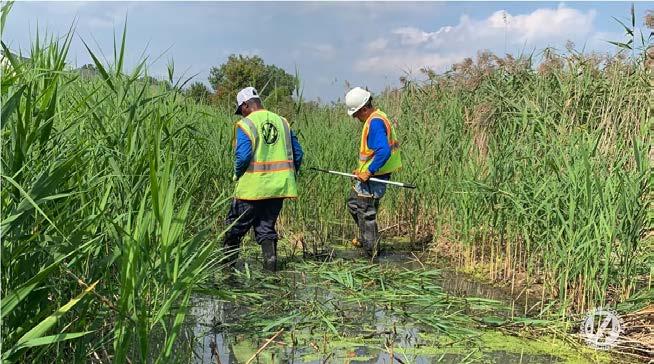
Thanks to our partnership with Six Rivers Land Conservancy on a grant funded project called "Cut to Drown," a successful method to control invasive phragmites commonly seen in creeks, streams and other open drains, our Public Works team was able to successfully mitigate a few problematic drains. Cut to Drown can be used by private property owners and homeowner associations as an alternative to chemical treatments by licensed contractors, to kill the invasive species in private ponds and retention basins. For more information on how to reduce phragmites, visit our resources page on our website.
Macomb County Public Works Commissioner Candice S. Miller was joined by County Executive Mark Hackel and more than two dozen other officials and volunteers to plant 54 trees last fall at the Harrison Township park where the Clinton River Spillway meets Lake St. Clair.
Trees act as green infrastructure by improving storm water management and water quality, reducing carbon dioxide and increasing the shade canopy. The event was a partnership between the Public Works Office and the Detroit Zoological Society, in collaboration with Harrison Township, ReLeaf Michigan and Green Macomb.
“This was a wonderful team effort that improves the environment immediately and for decades to come through green infrastructure, contributing to quality of life by also making the park more enjoyable to area residents and visitors for generations,” Miller said. “The rainy weather wasn’t great for volunteers, but it was great for the trees!”
The variety of trees planted at Jefferson Spillway Park include: swamp white oak, triumph elm, prairie fire crabapple, skyline honeylocust, Japanese lilac, American hophornbeam, London planetree, Princeton sentry ginkgo, Redmond linden and emerald arborvitae. The cost of the trees was split evenly between the Clinton River Spillway Authority and the Detroit Zoological Society.


